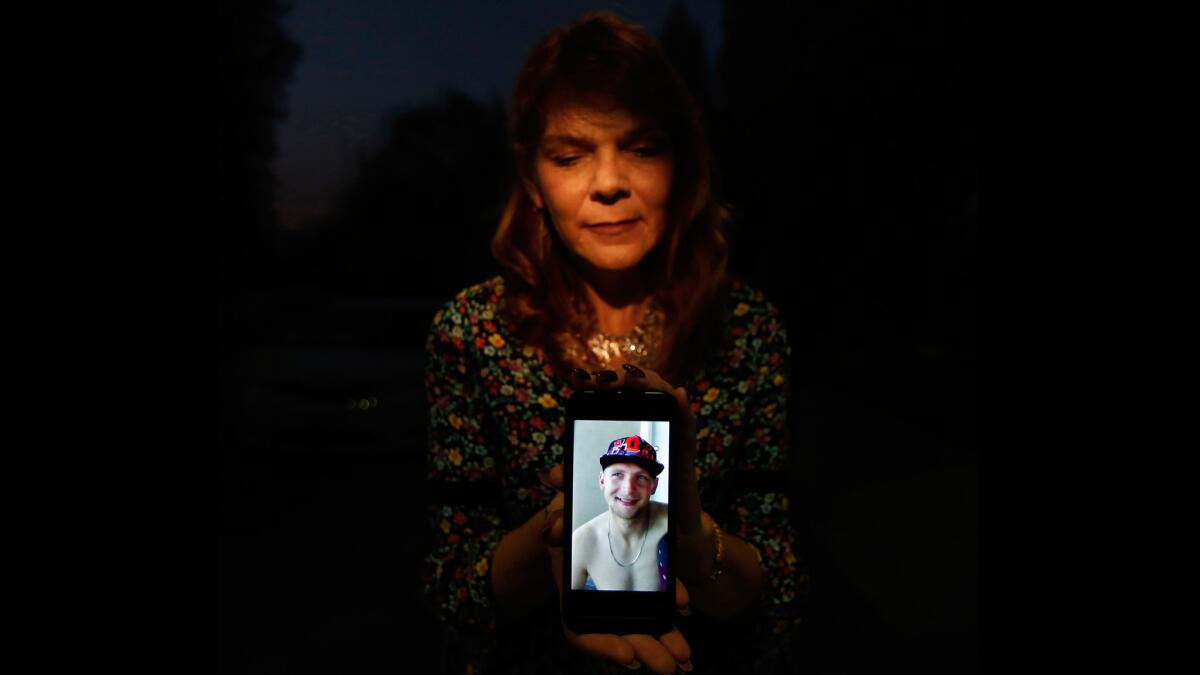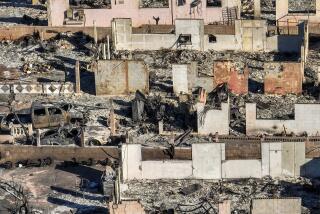For families of dozens missing in California wildfires, ‘it’s emotional limbo’

Gina Russell never used to answer calls from unknown numbers.
That changed last week when wildfires roared through Santa Rosa, where her son was staying.
Nine days later, Russell’s son Christopher Le Loup, 26, still hasn’t contacted her. She picks up her phone every time it rings, desperate for news that has not come.
The questions run relentlessly through her mind: Is he with friends? Is he hurt? Is he even alive?
“Not knowing is the hardest part,” Russell said, her voice breaking. “Whatever happened to him, wherever he is.… Please, God, I need to know. Anything has to be better than this.”
More than a week after wildfires swept through Northern California, killing more than 40 people and displacing thousands of others, Russell and more than 50 other families are still searching for loved ones, lost in the chaos of the fire and the evacuation.
Some Sonoma County residents left their cellphones and computers behind as they fled, or don’t have access to email. Others never left home.
“It’s emotional limbo,” said Shirlee Zane, who worked as a grief counselor before being elected to the Sonoma County Board of Supervisors. “You can’t grieve, because you don’t know what happened yet.”
Clinging to hope and contemplating the other outcome at the same time can cause anxiety and stress almost as scarring as the loss itself, Zane said.
By Tuesday, Sonoma County detectives had whittled nearly 2,000 reports of missing people down to 53. Detectives are speaking to loved ones, co-workers and shelter officials to rule out whether the missing could be with friends, neighbors, colleagues or anywhere else.

It is a grim process of elimination that too frequently is leading back to the missing person’s home, Sonoma County Sheriff Rob Giordano said. More often than not, they find the household’s lone car still parked in the driveway.
“When we can’t lower that number anymore, when we stop finding people, and we start narrowing our list down,” families will have their answer, Giordano said.
The search process will take several weeks, at least. There is a chance some victims will never be found.
In rare cases, officials have been happy to be wrong about a victim. Earlier this week, after sifting through the rubble of a Mark West Spring home, a volunteer search crew erupted in cheers. The home’s owner, a 91-year-old woman, had been found alive and safe, miles away.
Russell and other families cling to those bits of good news, and to the other stories still surfacing: The man who learned his missing friend had attended Mass on Sunday, a week after the fire raced through his neighborhood. The woman who traced her cousin to a motel after posting a plea on Facebook. The couple who realized their neighbors had not been trapped in their house but on vacation.
But Russell has heard nothing.
For days, she has contacted friends, family and businesses, repeating the details she knows about her son: Le Loup has blond hair and blue eyes. He was staying with a friend in Santa Rosa just before the fire. He had no photo ID.
When Le Loup called his mother, she wired him $20, and asked him to be careful.
“Be careful?” Le Loup asked. “Is something going to happen?”
“You know I worry about you,” Russell responded.
Le Loup has schizophrenia, and suffers from mood swings and periods of confusion, Russell said. But he never goes a week without calling — even if it’s just to ask for money or help, which he would certainly need after a disaster, she said.
The scenarios play out in her head, over and over: He could be with a friend, but disoriented or scared. He could be hurt, in a hospital somewhere. The other possibility, she doesn’t want to contemplate.
Searching for missing elderly residents has been a challenge, too. Many are socially isolated, Zane said. Some don’t drive. Others don’t have phones. A few may be distressed, unable to remember phone numbers or email addresses for their loved ones.
The cruel twist, Zane said, is that elderly victims who died may be easier to identify. Joint replacements survive strong fires. The pieces come with serial numbers that can be traced.
As the days of not knowing stretch on, friends and loved ones persevere in their search for answers.
“Excuse me, excuse me,” said Maria Hernandez, as she walked from car to car in the parking lot of a Red Cross shelter in Santa Rosa. “Have you seen this man?”
She held up a blurry photo of Victor Oteri, a friend of her mother who lived at the Journey’s End mobile home park, one of the areas hit hardest by the wildfires.
Hernandez had searched the city’s shelters, and had tried to check the “Safe and Well” site. But the database requires the person’s phone number or complete address, and her elderly mother didn’t know either.
“We are trying to stay optimistic,” Hernandez said. “But it’s been more than a week. We don’t know what to think.”
Some of those who survived the fire are still out of reach.
When Ellen Wade’s mobile home was destroyed, her son, Lincoln Loving, taped posters around Santa Rosa, focusing on the bulletin boards posted outside malls and grocery stores that show the progress of the fire.
The poster shows Wade and her boyfriend, Joe, smiling at her son’s wedding. Neither of them had a cellphone or internet access, the poster said, and “they do not have anyone’s contact information.”
Days later, Loving learned Wade had been seen at a shelter. But he didn’t know which one, and he still hasn’t spoken to her.
“It’s good that she’s safe, or we think she is,” Loving said. “We want to see her.”
For more than a week, Bridget McShea of Fremont searched for her 96-year-old cousin Ted McCarthy, who also lived at Journey’s End. She emailed him on the Monday after news of the massive fires broke and heard nothing for days, although he’s usually diligent about responding quickly.
“There is a point when you begin to consider harsher realities,” McShea said. She reported him missing. She contemplated calling hospitals.
First, she turned to Facebook, posting a photo of McCarthy and his wife with a plea for help.
As friends and strangers shared the post, tips began to come in. An employee at a car dealership saw them nearby. They were spotted seeking federal assistance.
“I assumed they were out there, and coudn’t easily contact us,” McShea said. “What helped me keep looking and keep trying was hope.”
Finally, late Tuesday, a member of her cousin’s church texted McShea to say that the couple was safe with them.
Russell is hoping her son’s situation is similar — staying with a friend somewhere, perhaps, or even hurt in a hospital. As long as he’s alive.
“I would not wish this feeling on anybody,” she said. “It has been so many days. It’s hard not to lose faith.”
For more transportation news, follow @laura_nelson on Twitter.
ALSO
Residents advised to close windows after fire erupts at Chevron oil refinery in El Segundo
How Washington’s formula for fighting wildfires makes them worse
New fires in Sausalito, Santa Cruz and Dublin force evacuations
More to Read
Start your day right
Sign up for Essential California for news, features and recommendations from the L.A. Times and beyond in your inbox six days a week.
You may occasionally receive promotional content from the Los Angeles Times.







